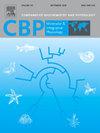在恐惧诱发的暴力性高温急性发作后,冷却是否会影响骨骼肌糖原的补充?
IF 2.2
3区 生物学
Q4 BIOCHEMISTRY & MOLECULAR BIOLOGY
Comparative Biochemistry and Physiology A-Molecular & Integrative Physiology
Pub Date : 2025-08-12
DOI:10.1016/j.cbpa.2025.111921
引用次数: 0
摘要
横纹肌溶解是野生动物捕获性肌病的临床症状,可能与糖原代谢有关。为了研究可能的机制,将26只野生小羚羊追捕15 min并固定,然后将其中12只小羚羊用冰水浸泡(n = 14只追捕组;N = 12追赶组+冷却组)。另外12本福书作为静息(非追逐)非冷却对照。固定后行股外侧肌活检进行生化分析。在最初捕获、运动后3天和16天进行活组织检查,分析糖原含量。南非白面大羚羊主要肌肉中肌球蛋白重链(MHC)活动花絮(~ 50 ± 9 %),其次是IIX(32 ±10 %)和MHC I(18 ±5 %),与组之间没有差异。柠檬酸合成酶(意思是:87 ± 48),3-hydroxyacetyl有限公司一个脱氢酶(47 ± 17),乳酸脱氢酶(1567 ± 654),磷酸化酶(162 ± 94),磷酸果糖激酶(250 ± 123)和肌酸激酶(12455 ± 6372)活动(μ摩尔/分钟/ g prot)没有不同组。同样,超氧化物歧化酶(7.9 ±7 U / mg prot)、过氧化氢酶(8.8 ±5.8 更易/分钟/ g prot),和总抗氧化能力(氧自由基吸收:23055 ±18460 μ摩尔/ g prot)没有不同组。两组的糖原含量均有所降低,且在第3天未得到补充。第16天,两组均出现糖原超代偿(比静息对照组高~33 %)。结果证实,布莱斯克具有高肌肉代谢能力,并且糖原再合成缓慢,这可能导致长时间追逐事件中代谢物缺乏(bbb15 min)。本文章由计算机程序翻译,如有差异,请以英文原文为准。
Does cooling affect skeletal muscle glycogen replenishment after an acute bout of fear-induced exertional hyperthermia in blesbok (Damaliscus pygargus phillipsi)?
Rhabdomyolyses is a clinical sign of capture myopathy in wild animals and may be linked to glycogen metabolism. To study potential mechanisms, 26 wild blesbok were chased for 15 min and immobilised, whereafter 12 of these blesbok were doused with ice-water (n = 14 chased only group; n = 12 chased + cooled group). An additional 12 blesbok served as resting (not chased) uncooled controls. Vastus lateralis biopsies were obtained after immobilisation for biochemical analyses. Biopsies obtained at initial capture, 3- and 16-days post exercise were analysed for glycogen content. Blesbok muscles contained predominantly myosin heavy chain (MHC) IIA (∼50 ± 9 %), followed by IIX (32 ± 10 %) and MHC I (18 ± 5 %), with no difference between groups. Citrate synthase (mean: 87 ± 48), 3-hydroxyacetyl co A dehydrogenase (47 ± 17), lactate dehydrogenase (1567 ± 654), phosphorylase (162 ± 94), phosphofructokinase (250 ± 123) and creatine kinase (12,455 ± 6372) activities (in μmol/min/g prot) were not different between groups. Similarly, superoxide dismutase (7.9 ± 7 U/mg prot), catalase (8.8 ± 5.8 mmol/min/g prot), and overall antioxidant capacity (ORAC: 23055 ± 18,460 μmol/g prot) were not different between groups. Glycogen content was reduced in both chased groups and not replenished by day 3. Glycogen supercompensation was observed on day 16 in both chased groups (∼33 % higher than resting control group). The results confirm that blesbok have high muscle metabolic capacities, and that glycogen resynthesis is slow, which could lead to metabolite deficiency during prolonged chase events (>15 min).
求助全文
通过发布文献求助,成功后即可免费获取论文全文。
去求助
来源期刊
CiteScore
5.00
自引率
4.30%
发文量
155
审稿时长
3 months
期刊介绍:
Part A: Molecular & Integrative Physiology of Comparative Biochemistry and Physiology. This journal covers molecular, cellular, integrative, and ecological physiology. Topics include bioenergetics, circulation, development, excretion, ion regulation, endocrinology, neurobiology, nutrition, respiration, and thermal biology. Study on regulatory mechanisms at any level of organization such as signal transduction and cellular interaction and control of behavior are also published.

 求助内容:
求助内容: 应助结果提醒方式:
应助结果提醒方式:


